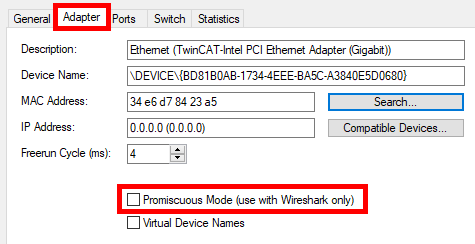Network adapter
There are several things to consider when selecting, configuring and using a network adapter, which are listed and described individually below:
- First, a suitable network adapter that is supported by our TwinCAT Realtime Ethernet driver must be chosen so that the driver can be installed and used in real-time operation.
- All other network protocols that are not required should then be disabled for this network adapter in order to prevent interferences in communication.
- After setting up a camera for the first time, a persistent IP address should be set in the IP-Stack of the TwinCAT project.
- If several cameras are to be operated on the same port of the network adapter, additional settings must be made in the IP-Stack.
- Finally, you will find a few notes on the diagnostic options.
TwinCAT RT Ethernet adapters
Similar to the connection of EtherCAT devices, the TwinCAT Realtime Ethernet driver must be installed on the corresponding network adapter to enable connection to GigE Vision devices. To open a corresponding installation dialog, click TWINCAT > Show Realtime Ethernet Compatible Devices in the Visual Studio menu.
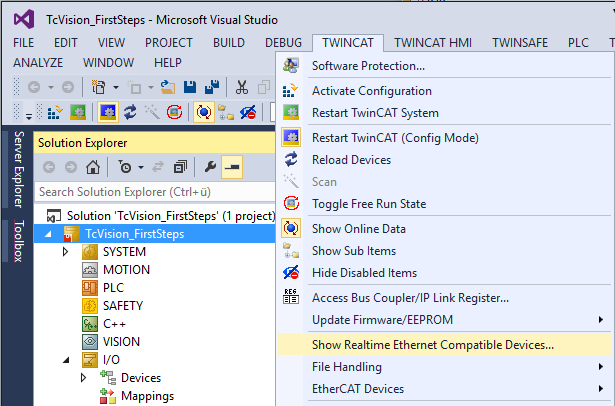
Alternatively you can call the file C:\TwinCAT\3.1\System\TcRteInstall.exe on the target system; this also opens the corresponding installation assistant.
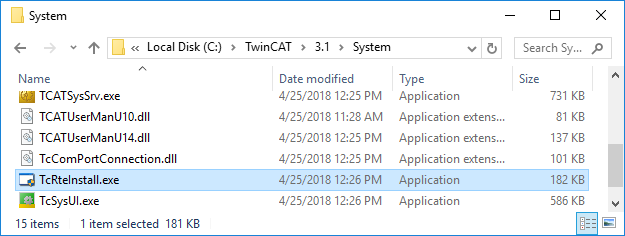
In the installation assistant, make sure that the corresponding network adapter is listed under Installed and ready to use devices (realtime capable). If this is not the case, select an appropriate adapter from the list of Compatible devices and click Install.
Notice | |
For demo use only This status is not sufficient for a stable connection and operation of GigE Vision devices. If the network adapter is only listed under this group after installation, a different adapter must be used. |
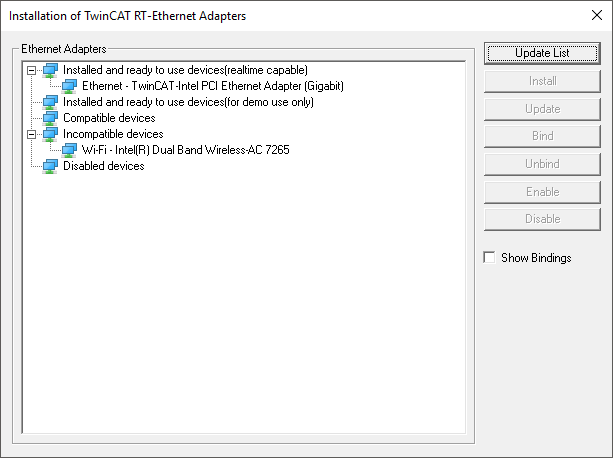
Other network protocols
It is recommended to restrict the use of the network adapter to the TwinCAT Ethernet protocol and to assign a persistent IP address via the IP-Stack in the TwinCAT project. Because if several protocols have access to the network adapter, they could send packets that could cause errors in the camera communication. The setting for this can be found in the Windows properties of the network adapter.
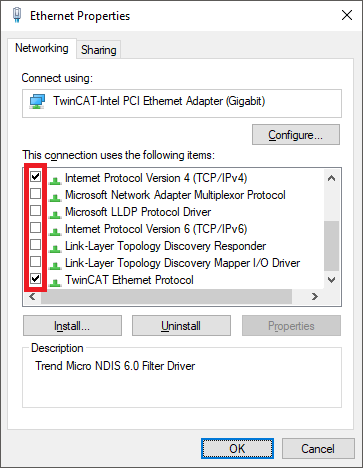
Internet Protocol version 4 (IPv4) is only required if DHCP is to be used to set up the camera connection. When setting up a camera for the first time, the automatic assignment of a link-local address (LLA) can be helpful. In all other cases or after completing the initial settings, you can also disable the IPv4 protocol and configure the IP address manually in TwinCAT in the IP-Stack.
Notice | |
Disabling other network protocols If possible, disable all network protocols on your Ethernet adapter except for the TwinCAT Ethernet Protocol. Otherwise, errors and delays may occur in the communication with GigE Vision cameras. |
Specifying a persistent IP address
If the PC should not automatically specify the IP address of the network adapter, but instead you wish to manually specify a persistent IP address, you can do this in TwinCAT as follows:
- 1. Open the IP-Stack of the RT-Ethernet adapter in the I/O configuration.
- 2. Select the Parameter (Init) tab and display further parameters by clicking the Plus (+) in front of
TcIoIpSettings. - 3. Specify the parameters
.IpAddressand.SubnetMask. - 4. Set the parameter
.ManualSettingstoTRUE.
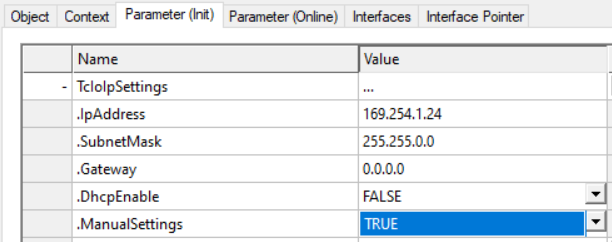
The same setting is automatically assigned if you assign a manual IP address when creating a camera object. Alternatively, a persistent IP address can also be defined via the Windows Network Adapter properties.
Notice | |
Persistent IP addresses To prevent the IP address of the network adapter from changing, specify a persistent IP address in the IP-Stack of the TwinCAT project. |
Operating multiple cameras on one port
If you want to operate several cameras on the same RT Ethernet adapter, you must make sure that the UDP/IP settings allow this. Navigate to the UDP/IP stack under the RT Ethernet device and select the Parameters (Init) tab.
In the parameter list that appears, set IpMaxReceivers and UdpMaxReceivers such that they correspond to twice the number of cameras connected via this adapter. This is because there are two receivers per camera (GVCP and GVSP modules). The standard setting allows two camera connections, for which reason the parameters are set to 2 * 2 = 4.
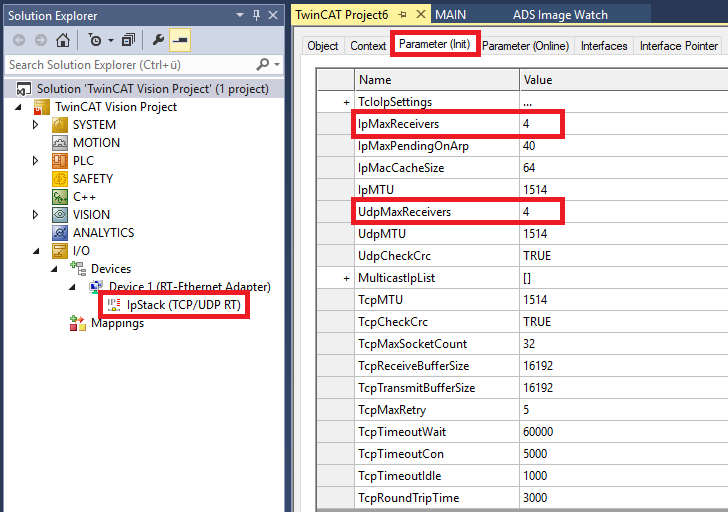
Diagnostics
In case of problems with the connection, especially with sent or received frames, you will find a tab with statistics information in the RT Ethernet adapter and in the IpStack the Parameter (Online) tab with individual counter information. Details can be found in the appendix/troubleshooting at Camera communication.
Promiscuous Mode
Promiscuous Mode is a setting in TwinCAT RT Ethernet adapters. It is required for debugging purposes with the Wireshark tool. This mode can cause problems when communicating with GigE Vision devices.
Notice | |
Avoid Promiscuous mode This mode can cause problems when communicating with GigE Vision devices. GigE Vision devices should therefore be operated without Promiscuous Mode! |
You can check this setting by opening the corresponding RT-Ethernet adapter in Visual Studio and switching to the Adapter tab. The checkbox for Promiscuous Mode (use with Wireshark only) must be deactivated.

